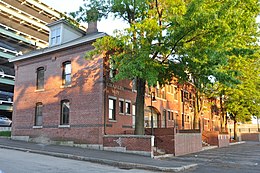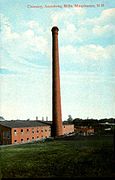George W. Stevens
George W. Stevens | |
|---|---|
| Born | October 1, 1834 Andover, Massachusetts, U.S. |
| Died | September 30, 1897 (aged 62) Cordova, Alabama, U.S. |
| Nationality | American |
| Occupations | |
| Spouse |
Anna Maria Annan (m. 1864) |

George W. Stevens (October 1, 1834 – September 30, 1897) was an American civil engineer and architect practicing in Manchester, New Hampshire, during the nineteenth century.
Life and career[edit]
George W. Stevens was born October 1, 1834, in Andover, Massachusetts,[1] to Phinehas Stevens (1800-1864). Phinehas Stevens was a millwright and built the New Mills of the Amoskeag Manufacturing Company in 1841, among other mills in New England.[2]
Stevens is first listed in the Manchester directories in 1866, as a civil engineer. By 1879 he was also noted in the directories as an architect,[3] though he was employed as an architect as early as the late 1860s. He lived in Manchester for about forty years, for eighteen of which he was employed as chief civil engineer for the Amoskeag Manufacturing Company. In 1892 Stevens left Manchester to join Lockwood, Greene & Company as superintendent of construction for their southern mills. He remained in this position for five years, living in the South. Stevens died in Cordova, Alabama, on September 30, 1897.[1]
Personal life[edit]
Stevens was married in 1864 to Anna Maria Annan (1837-1927) of Manchester.[4]
Augustus G. Stevens (1829-1901), elder brother of George W., was also an architect and engineer in Manchester, and designed the Hoyt Shoe Factory in 1892.[5]
Legacy[edit]
At least three buildings attributed to Stevens have been listed on the United States National Register of Historic Places, and another contributes to a listed historic district.
Works[edit]
- Manchester City Library (former), Manchester, New Hampshire (1869–71, demolished)[6]
- Lincoln Street School,[a] Manchester, New Hampshire (1871, demolished)[7]
- Ash Street School, Manchester, New Hampshire (1872–74, NRHP-listed 1975)[8]
- Old Post Office Block,[b] Manchester, New Hampshire (1876, NRHP-listed 1986)[9]
- Central Fire Station, Manchester, New Hampshire (1877, demolished 1971)[10]
- Dunlap Building, Manchester, New Hampshire (1879, NRHP-listed 2004)[3]
- House for George W. Stevens,[c] Manchester, New Hampshire (1879)[11]
- Amory Mill, Amoskeag Millyard, Manchester, New Hampshire (1880)[3]
- Housing for the Amoskeag Manufacturing Company,[d] Manchester, New Hampshire (1881, partially extant)[12]
- Bakersville School, Manchester, New Hampshire (1883, demolished)[13]
- Chimney,[e] Amoskeag Millyard, Manchester, New Hampshire (1883, demolished 1955)[15]
- Peoples' Baptist Church, Manchester, New Hampshire (1888, demolished)[3]
Gallery of works[edit]
-
Manchester City Library (former), Manchester, New Hampshire, 1869
-
Ash Street School, Manchester, New Hampshire, 1872-74
-
Central Fire Station, Manchester, New Hampshire, 1877
-
Housing for the Amoskeag Manufacturing Company, Manchester, New Hampshire, 1881
-
Chimney, Amoskeag Millyard, Manchester, New Hampshire, 1883
Notes[edit]
- ^ Demolished to build Enright Park.
- ^ The architect of the Post Office Block is not documented, but Stevens is suggested as the most likely designer.
- ^ The house Stevens built for his family still stands at 1819 Elm Street.
- ^ Stevens designed four rows of houses for the company in 1881, one of which remains as a contributing resource to District C of the Amoskeag Manufacturing Company Housing Districts, NRHP-listed in 1982.
- ^ At 255 feet (78 m) tall, this chimney was the tallest structure in Manchester prior to its demolition.[14]
References[edit]
- ^ a b "Obituary," Engineering News 38, no. 15 (October 7, 1897): 127.
- ^ Manchester: A Brief Record of its Past and a Picture of its Present (Manchester: John B. Clarke, printer, 1875)
- ^ a b c d Dunlap Building NRHP Registration Form (2004)
- ^ Jedediah Herrick and Lucius C. Herrick, Herrick Genealogy: A Genealogical Register of the Name and Family of Herrick (Columbus: Lucius C. Herrick, 1885)
- ^ Hoyt Shoe Factory NRHP Registration Form (1985)
- ^ Annual Reports of the City of Manchester, for the Year 1869 (Manchester: John B. Clarke, printer, 1870)
- ^ Bryant F. Tolles Jr. and Carolyn K. Tolles, New Hampshire Architecture: An Illustrated Guide (Hanover: University Press of New England, 1979)
- ^ Ash Street School NRHP Registration Form (1975)
- ^ Old Post Office Block NRHP Registration Form (1976)
- ^ Thirty-second Annual Report of the Receipts and Expenditures of the City of Manchester, for the Fiscal Year Ending December 31, 1877, Together with Other Annual Reports and Papers Relating to the Affairs of the City (Manchester: John B. Clarke, printer, 1878)
- ^ "Building Intelligence," Manufacturer and Builder 11, no. 2 (February 1879): 32.
- ^ District C NRHP Registration Form (1982)
- ^ Thirty-eighth Annual Report of the Receipts and Expenditures of the City of Manchester, for the Fiscal Year Ending December 31, 1883, Together with Other Annual Reports and Papers Relating to the Affairs of the City (Manchester: John B. Clarke, printer, 1884)
- ^ Manchester[dead link], Emporis.com.
- ^ Robert M. Bancroft and Francis J. Bancroft, Tall Chimney Construction: A Practical Treatise on the Construction of Tall Chimney Shafts (Manchester: John Calvert, 1885)





